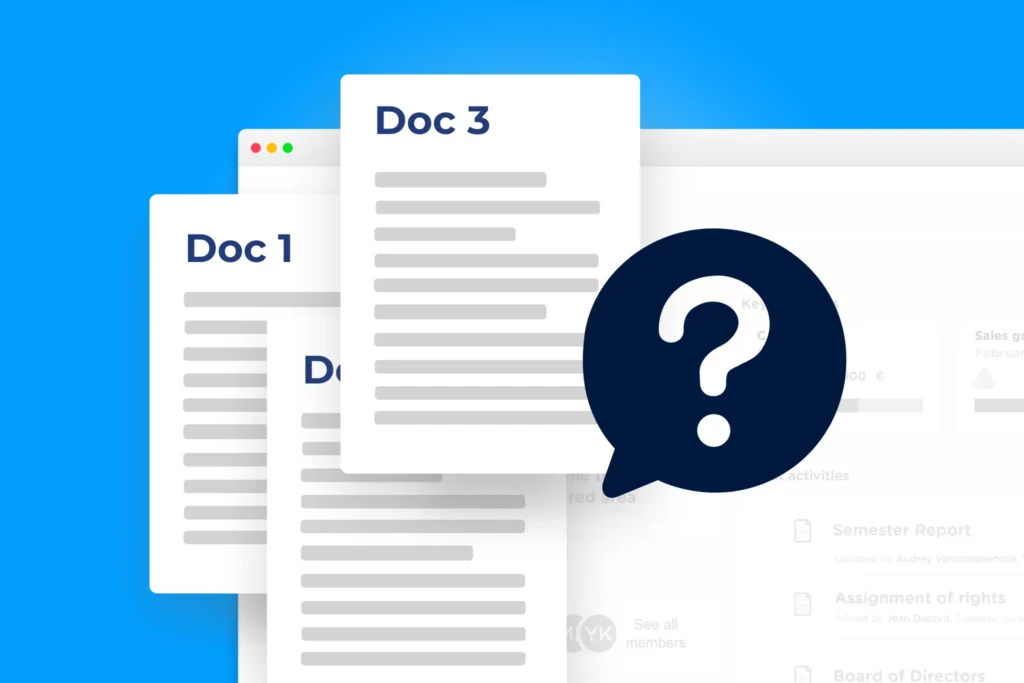Companies of all sizes handle a large number documents daily, which leads to concerns about security and productivity.
Moreover, with the rise of digital technologies and digitalization, the number of documents processed by organizations continues to increase, which entails a reinforced and secure management capacity
To ensure efficient management of their data, organizations need to create a document database that is intelligent, secure and accessible. This is the purpose of a document library, but let’s find out exactly what it is.

Definition of a Document Library
A document library groups together various documents in different forms: paper, digital, journals, archives, and sound or video content types. It serves as a place to store and manage a list of files with clear structures. A library in SharePoint or similar platform often displays a list of items that can be created or modified as needed.
In some companies, records managers are in charge of building and managing archives according to a well-defined strategy, but this is far from the norm in all companies.
However, the main objective of this kind of collection is to optimize access to information for companies. The selected resources are organized according to predefined criteria, such as utility (the document could be used at a later date), or legal value (the law requires that certain types of documents be kept).
Organizations draft and receive an important number of resources on a daily basis that will fill up this document library. Updating and managing this tool requires rigorous organization: each new file must be selected, classified in the appropriate folder, and archived securely. The use of a document library is a major asset for companies.
Why use a document library?
Setting up a document library meets three key objectives:
- Preserving digital files and folders of documents for legal and regulatory reasons
- Facilitating the search for, and access to, archived resources when needed
- Improving the flow of information within teams
While most documents are stored for legal reasons, others are still accessed regularly by employees. Other resources are kept as evidence to document the company’s history.
In any case, the use of a document library can help companies because it allows them to control information.
Benefits of documentation libraries
Employees that have access to a large amount of relevant information and a centralized document collection have a clear advantage on several points/levels:
- Improved productivity and better efficiency: no more time wasted searching for an important document, employees save time and boost their efficiency. A well‑organized library makes files easier to find.
- Better decision-making: knowledge is power, the more relevant information employees have access to, the easier it is to make informed decisions.
- Straightforward communication: the centralization of all resources allows a better flow of communication both internally within the organization and also with customers and business partners. Teams can also collaborate on files in real time.
- Stronger security: it is paramount to secure critical and confidential files to avoid losses and information leaks that could lead be costly in financial, legal and strategic terms.
All teams need to keep a paper trail or use certain resources for strategic reasons. It is therefore crucial for employees to have access to a library to serve as the main content repository. With different permission levels, administrators can also check access or receive a notification when someone modifies or attempts to delete a file.
With the rise of digital technologies and digitalization, the number of documents processed by organizations continues to increase, which entails a reinforced and secure management capacity.
Document library solutions
Many organizations rely on platforms like Microsoft SharePoint to set up document libraries, manage folders, and store documents across teams. A typical SharePoint document library allows users to create a new site, manage permission levels, and share multiple files internally.
However, for companies that deal with sensitive data, legal compliance, or require higher security and auditability, these standard solutions often fall short.
That’s where DiliTrust’s documentation library goes the extra mile.
How can DiliTrust help you manage your organization’s documents?
A key component of successful corporate governance is efficient corporate document management.
Digital tools make it possible to go beyond simple management of document storage. DiliTrust is a SaaS suite with a Documentation Library module, which provides an intelligent and secure central repository for all documents with several advantages:
Access rights can be fine-tuned and customized, while statistical reports allow administrators to monitor the actions performed by each user. DiliTrust puts security at the center of everything.
The data stored in the document library is not shared in the cloud, this guarantees optimal security and confidentiality for particularly sensitive documents.
With no limit on storage, the DiliTrust Documentation Library can contain an unlimited amount of resources, which are all classified in a tree structure for easy management.
The tool’s structure and user-friendly interface make it easy to find relevant information, saving time and improving efficiency.
The access rights policy is fully customizable for each project, and stakeholders can collaborate on documents in real time.
If you would like to know more about DiliTrust’s Documentation Library module, contact one of our experts!
This content may also be of interest to you:.


